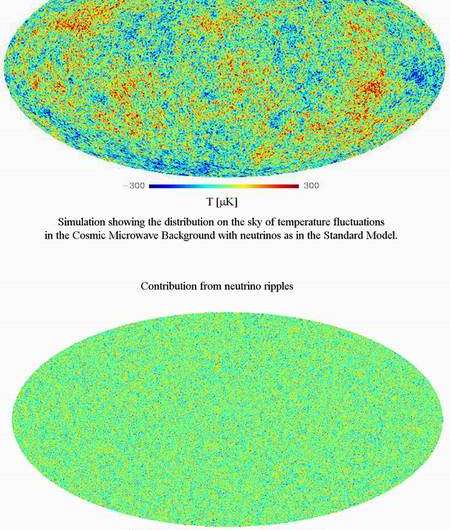Ripples In Cosmic Neutrino Background Measured For The First Time
Astrophysicists from the Universities of Oxford and Rome have for the first time found evidence of ripples in the Universe’s primordial sea of neutrinos, confirming the predictions of both Big Bang theory and the Standard Model of particle physics.
Neutrinos are elementary particles with no charge and very little mass, which are extremely difficult to study due to their very weak interaction with matter. Yet pinning down the physical properties of neutrinos is of paramount importance to scientists attempting to understand the fundamental building blocks of Nature. According to the standard Big Bang model, neutrinos permeate the Universe at a density of about 150 per cubic centimetre. The Earth is therefore immersed in an ocean of neutrinos, without us ever noticing.
Although it is impossible to measure this ‘Cosmic Neutrino Background’ directly with present-day technology, physicists predict that ripples or waves in it have an impact on the growth of structures in the Universe.
In research to be published in the journal Physical Review Letters, Dr. Roberto Trotta, Lockyer Fellow of the Royal Astronomical Society at Oxford’s Department of Physics, and Dr. Alessandro Melchiorri of La Sapienza University in Rome were able to demonstrate for the first time the existence of ripples of primordial origin in the Cosmic Neutrino Background.

The discovery, made by combining data produced by the NASA WMAP (Wilkinson Microwave Anisotropy Probe) satellite and the Sloan Digital Sky Survey, confirms the predictions of both the Big Bang theory and the Standard Model of particle physics. The research has important implications for the study of neutrinos, showing that theories of the infinitely large (cosmology) and the infinitely small (particle physics) are in agreement.
Dr. Trotta said: “This research provides important new evidence in favour of the current cosmological model, unifying it with fundamental physics theories. Cosmology is becoming a more and more powerful laboratory where physics not easily accessible on Earth can be tested and verified. The high quality of recent cosmological data allows us to investigate neutrinos in the cosmological framework, obtaining measurements which are competitive with – if not superior to – particle accelerator findings.”
The paper “Indication for Primordial Anisotropies in the Neutrino Background from WMAP and SDSS” by Roberto Trotta and Alessandro Melchiorri has been accepted for publication in Physical Review Letters.
Source: Royal Astronomical Society (RAS)
















